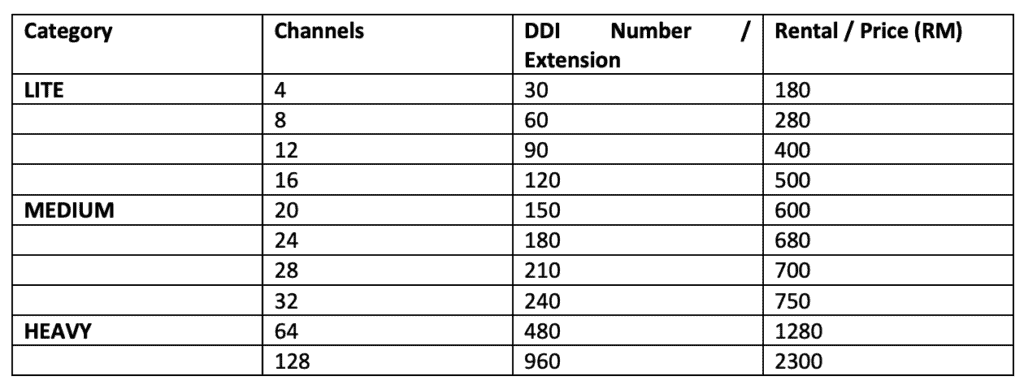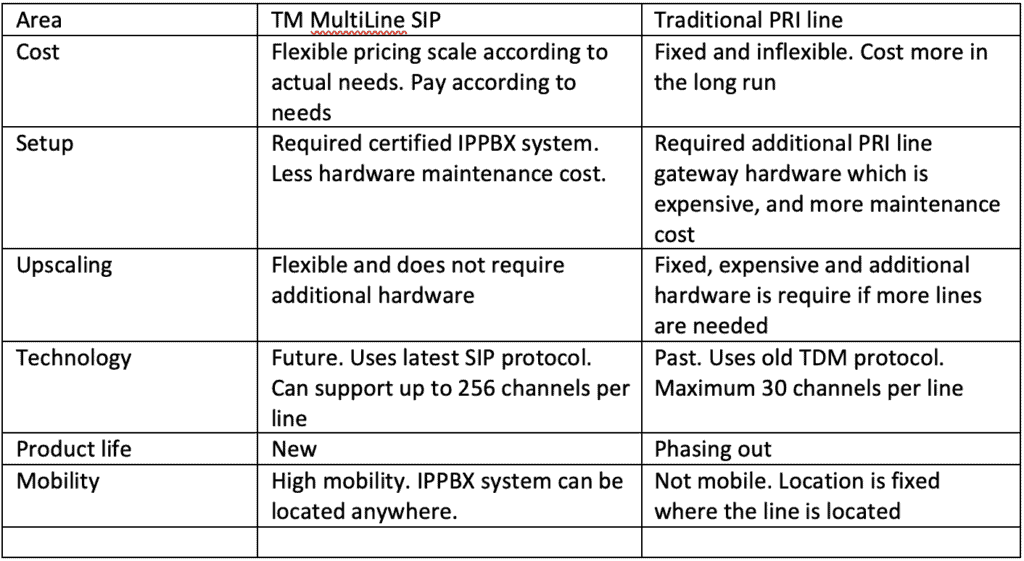Artikel ini boleh didapati dalam Bahasa Melayu di sini.
Updated: 9th April 2023
Companies of all sizes and functions use Telekom Malaysia’s (TM) PRI which carries voice over digital network using either copper or fibre cables into your office premises.
PRI, or Primary Rate Interface carries 30 channels here in Malaysia using UK standards.
What is TM MLS?
TM MLS, also known as Multi Line SIP, was introduced a few years ago, and now, TM actively encourages customers to sign up for MLS instead of PRI, its new fixed line package.
This makes perfect sense since MLS utilises the existing infrastructure laid for Unifi and Streamyx, eliminating the need to run coax cables all around new locations. As PRIs won’t be available anymore, companies need to start considering migrating from PRI to MLS.
However, several things need to be considered before making the switch. Here, we discuss 7 topics to think about before switching to MLS or adopting new MLS altogether.
7 Considerations When Moving To TM MLS.
Here we dive and discuss 7 priorities to consider when migrating to MLS from an existing PRI setup. These are;
- Telephone server or PBX
- Office telephone number
- Security & Privacy
- Call volume or channels
- Rental and other costs
- Value added features
- Fax or other telephony uses
1) Telephone server or PBX
TM MLS works on RFC standard internet protocol called SIP or Sessions Initiation Protocol. This protocol is an extremely mature and robust protocol that supersedes its predecessor, the H323 protocol.
SIP carry voice, video and text with higher numbers and call quality channels on a single cable when using fibre (as compared to PRI which is typically 64kbps and 30 channels respectively).
When you need to migrate to MLS, your PBX needs to support SIP terminations and would need to create a sip trunk. Many companies are still using traditional or aged PBXes that might not be able to directly support SIP.
In addition to that, your PBX also needs to be certified to use TM’s MLS through your vendors with TM’s PBX certification program. Most old PBXes still only supports PRI cards or ports and some even cannot be upgraded or migrated to SIP capabilities.
Some, however, can upgrade relevant hardware to support SIP at its termination without fully changing your PBX to IP, but this might cost you as most of these hardware could be no longer in production.
So if you’re on an older/unsupported PBX, here are some options;
- Get an upgrade of your PBX to be completely IP enabled
- Get a cards that supports SIP/MLS
- Get a SIP to PRI conversion device (a gateway)
For item 3, there are many products that can do that in the market. Your existing PBX must support a different kind of protocol that chains two PRI devices together. This is not always possible as some PRI cards/ports can only support telco type of termination, e.g. TM’s PRI.
G400 Digital Gateways by Sangoma, an example device you can use to interconnect with MLS on your traditional PBX by converting MLS to PRI and connect the PRI back to your PBX, like you do now.
In that case, your only option is to upgrade the entire system. If you wish to test if your PRI is capable for chaining, let us know by contacting us here.

2. Office telephone number
It’s a common concern when migrating from PRI to MLS: can businesses keep their existing phone numbers? In most cases, TM allows for number retention or portability, from all the cases we’ve worked on.
This means that businesses can retain their sets of numbers, including the pilot number and all individual numbers or DIDs, when switching to MLS.
Moreover, this portability also extends to cloud-based MLS, allowing businesses to choose their preferred location and have TM route calls accordingly.
This feature is especially useful for cloud PBXs, which rely on flexible and remote connectivity. If you’re using a toll free number as the main purpose of using PRI, then it is even easier, you just then need to ask TM to route the 1300/1800 destinations to the new pilot numbers from your newly provisioned MLS.

3. Security & Privacy
Since MLS uses internet protocol (IP), this means, if in an unlikely event of a breach at TM’s assets, bad guys can have access to your network.
All it takes is someone to access the internal networks of MLS and they can perhaps have unfettered access to your PBX and possibly to your internal network too.
It is a very good idea to isolate MLS network completely. Do consider the following;
-
- Place a firewall or sessions border controller (SBC) before the PBX so that you only allow SIP related ports. From TM’s equipment to TM’s infra, there’s no need to block anything but from TM’s Ethernet cable to your PBX, only allow SIP 5060 and several RTP ports as required by your PBX, something like 10000-12000 (range) is probably sufficient. You need to refer to your PBX setup guide on the ports required to be opened. (see diagram above – interconnectivity diagram). However, we are opined that an SBC isn’t needed as this is not publicly exposed, it’s only an internal private network built by TM’s routers and modem.
- Set up restrictions on your PBX IP access control list or firewall to only allow those ports if it’s possible, as many PBXs are basically software sitting on operating systems like Windows or Linux which have firewalls built in them.
If you’re upgrading to a SIP/IP PBX or already using one and plan to expose it to your company’s users outside the office network via software phone or similar, it’s critical to secure your PBX.
You can do so by using a VPN, SBC, or firewall that’s aware of SIP applications and can safeguard your PBX. SIP attacks are becoming increasingly common, typically in the form of brute force password attacks attempting to register and make costly calls to exotic numbers or services.
Here’s an article we wrote if you’re interested to read further on security/stability considerations.
4. Call volume or channels
TM publishes that each physical line can have a maximum of 128 channels (that’s a little more than 4 times of the capacity of a single PRI). If you need more channels, you could speak to your account representative in TM.
We have deployed a campus setup that could handle up to 500 channels on a single cable but that’s on a case to case basis. Otherwise, you might need more MLS physical lines inbound.
You need to take that into consideration especially if your PBX has limited RJ45 ports or you need to put the MLS behind a switch that will then send one or more MLS registration to your PBX.
5. Rental and other pricing
The good news is, TM MLS rental is going to be cheaper than PRIs. However, you still need a RM200 installation charge plus a RM1500 refundable deposit.
Let’s take PRI for example, it will roughly cost you RM900 per month for the rental of a PRI whilst with MLS, it’s just RM750 per month and you get 32 channels.
See table below for prices that we got from here. The DDI number here is sometimes also called your DID numbers and it’s usually a range of block numbers given to you which you can distribute it to your company individuals. The call charges will also likely be lesser.
Of course, there’s also cost of upgrading, maintaining and supporting new IP based PBXs and those too need to be considered moving forward. Alternatively, you can consider migrating to Cloud.
Cloud telephony is growing in popularity and we’ve seen a sharp uptake since the Movement Control Order first initiated by the Malaysian Government last year to curb the spread of Covid-19.
Cloud phone systems are secure, easy to use, works from anywhere and is simply cost effective for most organisations with the model of distributed (OPEX) cost rather than massive cash outflow investments (CAPEX).
TM has removed its pricing table on its website, somehow, but here’s something we got before they did, it may not be up to date and will also depend on taxes or other services charges like hardware.

LITE Plan
- Channels: 4 to 16
- DDI/DID: 30 to 120
- Price: RM 180 to RM 500
MEDIUM Plan:
- Channels: 20 to 32
- DDI/DID: 150 to 240
- Price: RM 600 to RM 750
HEAVY Plan:
- Channels: 64 to 128
- DDI/DID: 480 to 960
- Price: RM 1280 to RM 2300
TM actually can send up to 512 channels per fibre cable as we’ve done in a university here in Malaysia, you just have to insist 😉
6. Value added features
TM MLS doesn’t differ much in terms of features however, you need to know precisely what Value Added Services of TM MLS are, for instance, caller identification (inbound) is an optionally paid service.
Otherwise everything will work just like how it would using PRI, you have outgoing number presentation, hunting facilities (one number many calls), forwarding (with cost) and it’s easy to upgrade without pulling new cables.
For example, you’re on a 64 channel plan and you need additionally 32 more channels, it can be done from the same MLS cabling that’s already there.
You can also downgrade the channels if you don’t need them. The DID or DDI is also selectable unlike PRI which is fixed at 200 per PRI line. When you physically move locations, it may be much easier to keep your MLS numbers within certain conditions set by TM.
7. Fax or other telephony uses
Based on our tests so far, TM’s MLS can handle fax without any problem, this is done through T.38 or FOIP (Fax over IP) or G.711 (voice). We recommend that to use this protocol within the SIP stack of your PBX.
However, we found that it works fine without T.38 and using traditional methods (through g711 codec) albeit less reliable (e.g faxes come with thick black bars or distorted prints). T.38 however is far more reliable as it handles packet losses within its protocols to make faxes solid and reliable.
NOTE: Credit card terminals may not work well with IP based MLS. Please consider keeping your analogue lines for that.
Conclusion
In conclusion, you should consider migrating over to TM MLS to be future proof, reduce cost in the long run and probably scale up or down easier as your needs change.
What to Consider Before Moving to TM MLS?
Here are more things you can take into account or consider before moving to TM MLS. Remember, planning is key to ensuring a smooth transition. Usually, it should be a breeze but then again, don’t forget to plan.
1. Compatibility
Ensure that your existing hardware and software are compatible with MLS. This will prevent any issues or disruptions during the migration process.
2. Scalability
Consider the scalability of MLS to accommodate your business’s future growth. Ensure that it has enough capacity to handle any potential increases in call volume or additional features that you may need.
3. Cost
Evaluate the costs of MLS compared to your existing PRI setup. Take into account any hidden costs, such as additional equipment or licensing fees.
4. Reliability
Ensure that MLS is reliable and can provide the level of service and uptime your business requires. Check the provider’s uptime statistics, SLA, and redundancy features.
5. Features
Evaluate MLS’s features to ensure that they meet your business’s requirements. Consider features such as call forwarding, voicemail, call recording, and call reporting.
6. Support
Look for a provider that offers excellent customer support, with prompt response times and knowledgeable support staff. Check online reviews and ratings to gauge customer satisfaction levels.
7. Training
Plan for adequate training for your staff on how to use MLS. Ensure that the training is comprehensive and includes all the features and capabilities of MLS.
PRI vs TM MLS
Here’s a comparison table we made just to give you a glimpse of the differences between PRI and MLS offerings from TM.

Disclaimer
ORENCloud or Astiostech is an independent provider of PBXes and services, and we are not directly associated with TM. This article serves as an informational resource only, and readers should refer to official documentation from TM for accurate information on their MLS offering.
While we make significant efforts to ensure the accuracy and currency of the information presented, readers are encouraged to independently verify its accuracy.
Please note that ORENCloud or Astiostech cannot be held liable for any misconfigurations or business losses resulting from the use of this article or reliance on its advice. Readers should exercise caution and seek professional guidance in implementing any solutions based on the information provided.
Find out more information from TM here on their Business Voice Solution page or download the brochure here https://www.tmone.com.my/wp-content/uploads/2022/08/TM-One-Multi-Line-SIP-MLS.pdf
And of course, some marketing 😄
ORENCloud Sdn Bhd, a company fully owned and operated by Astiostech Sdn Bhd. Astiostech provides certified Telekom Malaysia TM MLS gateways and IP PBX with over 150 features and security parameters built-in to protect against intrusions originating from any networks connected to the PBX. ORENcloud provides cloud facilities that are certified by MCMC and fully supports TM MLS and any other SIP, H323, IAX2, Skinny, SS7, PRI, analogue and other telco termination requirements on a private or public cloud.
Start Your Digital Transformation Today

Try Out CloudOffice - Onpremise or Cloud
Shift to hosted cloud based unified communications, PABX or telephony system for a versatile, affordable, and feature rich phone system. Say goodbye to costly traditional systems and hardware. Alternatively, CloudOffice can be deployed in your office or private cloud.


